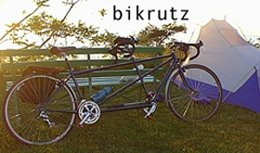

![]()
![]()
Today, we had programmed as a "rest day" Rest, at this stage of the trip, means, sleeping in, drying out, cleaning up, buying groceries, gasoline, and lunch, and biking from 1 to 4:30 PM.
Our campground last night was the Missoula KOA. Kampgrounds of America comes in for a lot of derision from those for whom camping is defined as trudging 12 miles to a mountain lake, eating a cold, dry dinner, and sacking out under the stars. Our family has actually done this many times, and, in fact, before this summer we had never been to an RV park. Within the world of such places, though, KOA is a rare brand name, a known commodity, somewhere with tolerable quality control. This one had the usual pool, and mini golf, along with the more rare dual hot tubs, and the downright exotic petting zoo. Miniature horses, goats, ducks, llamas, peacocks, chickens, and swans constituted the menagerie.
Shaine claims she decided on her career there. Watching a baby miniature horse trying to nurse, she stuck out her finger for it to suck. She had to kneel down, as the foal was about the size of our golden retriever. When it took her finger, she knew her life's work was to own and run a miniature horse farm.
On the way out of town, we stopped at Fort Missoula, the site of the Army's original encampment at the confluence of the Bitterroot and Blackfoot Rivers into the Clark Fork of the Columbia. Started in 1877, one year after the Army's grand loss of face by the Greasy Grass River at the hands of Sitting Bull and Crazy Horse (and 2000 warriors), the Fort served initially as a source of protection for western tribes such as the Salish and Nee-mee-poo (Nez Perce) trying to travel east through "Hell's Gate", a narrowing near the mouth of the Blackfoot. The tribe of the same name would wait behind the cliffs, attack the travelers, and take their goods.
Soon, the fort shifted from protector to herder of the natives. The Nez Perce, fleeing their homelands to the west, found hostility, not protection, and were forced by Missoula's soldiers onto their north Idaho reservation.
Twenty years later, the 25th Cavalry regiment was stationed at Missoula. A group of "Buffalo Soldiers", these black enlisted men were led by a white man, one Lieutenant Moss. Lt. Moss seems to have been enamored of the bicycle. He secured permission from his superiors to "test" the bicycle as a mode of military transportation. Obtaining free machines from the Spalding Co., he and six of his troopers took an excursion north to Lake MacDonald.
This went so well (or maybe Lt. Moss had so much fun), he equipped 20 of his men for a three week jaunt south to Yellowstone, where they were greeted as esteemed tourists. One photograph shows Lt. Moss and several of his men posed, with bicycles, on the Minerva Terrace of Mammoth Hot Springs.
Apparently, Lt. Moss convinced the Army brass that bicycles could serve as an alternative to the horse. He and his regiment set off the next summer across the Great Plains to St. Louis. Some pertinent details about that trip: bikes weighed 60-75 lbs, with gear (which was hanging from the handlebars); the bikes were single gear (chains covered), with no brakes; tires, though fat and pneumatic, were quite vulnerable to the dirt and mud over which they traveled - they sometimes would ride six hours, and repair wheels for seven.
The thing that clued me in to Lt. Moss' true intentions was his request the next year, 1898, for a mission from Missoula to San Francisco. That, the fact that two of his earlier trips were to national parks, and the fact that he hadn't made Captain yet, indicate to me that he and his men were just bike nuts, who loved dirt and difficulty and mechanical breakdowns as much as we mountain bikers of a century later. He was turned down, and sent to Cuba instead to fight in the Spanish American War.
Self-contained, with no roads and heavy, single-gear bikes, these men were true transcontinental two wheeled pioneers. Seen next to our high-tech, luxuriously supported trek, the 25th Cavalry were like Lewis and Clark compared to travels on the Northern Pacific Rail Road 80 years later.
Our biking started up the Bitterroot valley, then turned to follow Lolo
Creek. Slowly, persistently going uphill for 25 miles, we stopped often to admire the narrowing valley, to play in the creek, and, finally, to set up camp.
The remnants of a Pacific tropical storm have made it up to the Idaho panhandle. Coupled with 90 + F temps, a highly charged band of thunderstorms moved down Lolo Pass, 1000 feet above us. In addition to filling the air with cooling rain and happy ions, the storms also seemed the only thing which could frighten off the bees. It also saved us $20, what it would have cost to visit the hot springs across the road. They closed two hours early because of the storm. We spent the night inside, instead, getting ready to attack the last seven miles into Idaho the next morning.
-Al Bikrutz
Miles: Al (single) 33; Cheryl (single) 33; Rod, 45; Joan, 33.
Total Miles: 3034